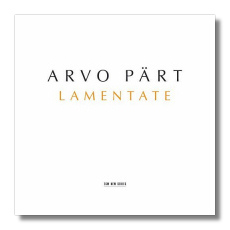
The Internet's Premier Classical Music Source
Related Links
- Pärt Reviews
- Latest Reviews
- More Reviews
-
By Composer
-
Collections
DVD & Blu-ray
Books
Concert Reviews
Articles/Interviews
Software
Audio
Search Amazon
Recommended Links
Site News
 CD Review
CD Review
Arvo Pärt

- Lamentate
- Da pacem Domine
Alexei Lubimov, piano
The Hilliard Ensemble
SWR Stuttgart Radio Symphony Orchestra/Andrey Boreyko
ECM New Series 1930 DDD 42:46
Arvo Pärt turns 70 on September 11, 2005. This CD, released less than two weeks before that date, contains première recordings of two recent works by the Estonian composer: a brief work for a cappella vocal soloists (Da pacem Domine, 2004) and the much longer Lamentate for piano and orchestra (2002).
The newer work was commissioned for a concert of music derived from a Gregorian antiphon imploring the Lord for peace now, not later, "because there is no one else who will fight for us, if not You, our God." Pärt has written many a cappella works for several voices or chorus, and this new one, apart from its concision, is typical. The intensity of Da pacem Domine – strongly devout yet never crude or pushy, is not a surprise from this composer. The Hilliards have recorded Pärt's music extensively, although they were not the first performers of this recent work. (That honor went to Jordi Savall's Hespèrion XXI and La Capella Reial de Catalunya in Barcelona.)
In 1968, Pärt wrote a work called Credo for piano, mixed choir, and orchestra. (It was recorded in 2003 by pianist Hélène Grimaud and conductor Esa-Pekka Salonen – Deutsche Grammophon B0001732-02). Credo seems to represent the superficial chaos present in a world where so many people believe so many different things, and yet it also raises the hope that resolution may come from the spiritual values which most people hold dear, regardless of what else they believe in.
In the mid to late 1970s, Pärt's music began to sound very different from Credo – it became much cooler and clearer. Spare, ethereal works such as Tabula rasa and Fratres began to define the new Arvo Pärt. With Lamentate, it sounds is if Pärt may be trying to reconcile the composer he was in the 1960s with the composer he became in the 1970s and 80s. Lamentate was inspired by a viewing of the immense figurative sculpture "Marsyas" by Anish Kapoor. (Marsyas was the satyr who challenged Apollo to a music contest, and who was flayed alive after losing.) Perhaps Marsyas represents both human aspiration (and arrogance?) and failure. In his notes to this CD, Pärt tells how he wrote Lamentate not for the dead, "but for the living, who have to deal with these issues [death and suffering] for themselves."
In Lamentate, the long paragraphs and subtle contrasts of latter day Pärt have been combined with the almost cinematic cross-cutting and dramatic atmospheres of his earlier works, including Credo. The ten connected sections of this work have titles such as "Minacciando" (menacing), "Pregando," (prayerfully), and "Fragile e conciliante" (fragile and conciliatory). There are violent outbursts. At time the music sounds like less Pärt and more like the work of another ECM New Series favorite, Giya Kancheli. In spite of his glances backwards and sideways, it seems that Pärt has moved forward decisively with Lamentate. He has written that Kapoor's sculpture motivated him to examine what it was that he wanted to accomplish in the time remaining to him. Listening to Lamentate, I can well believe it, and I look forward to hearing the new directions in which Pärt's music might travel. It's nice to hear a modern composer who remains true to himself, yet who doesn't repeat himself.
This is a short disc, but Lamentate (especially) will give listeners plenty to chew over. The performances seem ideal, as does the engineering.
Copyright © 2005, Raymond Tuttle




















